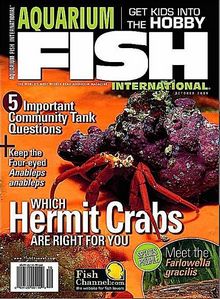Content and contributors
The magazine contained articles and columns on subjects including freshwater/tropical, saltwater/marine and brackish fish, as well as corals and invertebrates, planted tanks and aquascaping, fish breeding, species tanks, new species, fish food and nutrition, water chemistry, tank cycling, filtration, disease and health, fish husbandry and many other subjects such as aquarium equipment, setup, and maintenance.
Monthly columns included Freshwater Q&A, The Aquabotanist, Reef Aquarist, Adventures in Fish Breeding, Secrets to Society Success, Saltwater Q&A, FishKidz, Aquarist Notebook, Aquatic Maestro, Wet Vet, Sand Mail, Popular Freshwater Tropicals, Reef Notes, Freshwater Forum, In the Fish Room and Species Profile.
Animals that have appeared in the magazine include: clownfish, lionfish, cichlids, discus, butterflyfish, tetras, live-bearers, rasboras, triggerfish, starfish, freshwater shrimp, jellyfish, Acropora and brain corals, and more.
Over the years, Scott W. Michael, J. Charles Delbeek, Dick Au, Julian Sprung and many other members of the fishkeeping industry have contributed to Aquarium Fish International.
FAMA
Freshwater and Marine Aquarium (FAMA) magazine was first published in January 1978, and continued publication as a monthly consumer title under R/C Modeler until March 2005, when it was sold to BowTie Inc. Due to publication difficulties, FAMA's production schedule was interrupted until June 2005, when it resumed normal monthly publication under BowTie Inc. FAMA ceased publication with the June 2010 issue, when it was incorporated into AFI.
This page is based on this
Wikipedia article Text is available under the
CC BY-SA 4.0 license; additional terms may apply.
Images, videos and audio are available under their respective licenses.
